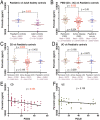Expression profile of the matricellular protein periostin in paediatric inflammatory bowel disease
- PMID: 33737520
- PMCID: PMC7973505
- DOI: 10.1038/s41598-021-85096-7
Expression profile of the matricellular protein periostin in paediatric inflammatory bowel disease
Abstract
The precise role of periostin, an extra-cellular matrix protein, in inflammatory bowel disease (IBD) is unclear. Here, we investigated periostin in paediatric IBD including its relationship with disease activity, clinical outcomes, genomic variation and expression in the colonic tissue. Plasma periostin was analysed using ELISA in 144 paediatric patients and 38 controls. Plasma levels were assessed against validated disease activity indices in IBD and clinical outcomes. An immuno-fluorescence for periostin and detailed isoform-expression analysis in the colonic tissue was performed in 23 individuals. We integrated a whole-gene based burden metric 'GenePy' to assess the impact of variation in POSTN and 23 other genes functionally connected to periostin. We found that plasma periostin levels were significantly increased during remission compared to active Crohn's disease. The immuno-fluorescence analysis demonstrated enhanced peri-cryptal ring patterns in patients compared to controls, present throughout inflamed, as well as macroscopically non-inflamed colonic tissue. Interestingly, the pattern of isoforms remained unchanged during bowel inflammation compared to healthy controls. In addition to its role during the inflammatory processes in IBD, periostin may have an additional prominent role in mucosal repair. Additional studies will be necessary to understand its role in the pathogenesis, repair and fibrosis in IBD.
Conflict of interest statement
The authors declare no competing interests.
Figures






References
Publication types
MeSH terms
Substances
LinkOut - more resources
Full Text Sources
Other Literature Sources
Medical
Miscellaneous

